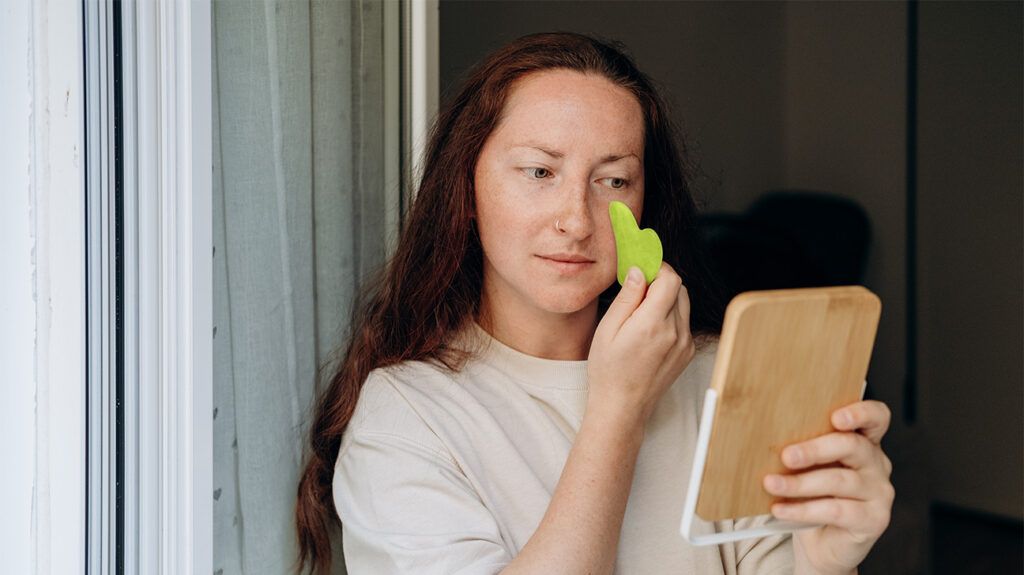Gua sha is a technique in traditional East Asian medicine. Some people use it to treat muscle pain and tension, but there is limited research into how well it works.
Gua sha aims to move energy, known as qi or chi, around the body. The treatment involves using a tool to rub the skin in long strokes, applying enough pressure to create minor bruising.
Gua sha may help break down scar tissue and connective tissue, improving movement in the joints. The technique does not have any serious side effects but is not suitable for those with certain medical conditions.
Due to its rise in popularity across social media platforms, many people use a lighter gua sha technique on the face and neck at home to help promote lymphatic drainage.
This article focuses on practitioner-led gua sha treatment, its effectiveness, and whether there are any side effects to consider.

Gua sha is the practice of using a tool to apply pressure and
The name gua sha — pronounced “gwahshah” — comes from the Chinese word for scraping. It may also be called skin scraping, spooning, or coining.
According to traditional Chinese medicine, qi or chi is energy that flows through the body. Many people believe that a person’s qi must be balanced and flowing freely to ensure their health and well-being.
People also believe that qi can become blocked, causing pain or tension in the muscles and joints. Gua sha aims to move this blocked energy to relieve aches or stiffness.
Traditional East Asian medicine also views blood stasis or stagnation as a cause of pain and illness. Another aim of gua sha is to move pooled or stagnated blood to relieve symptoms.
Some physiotherapists use a version of this
Some people anecdotally report positive results in lymphatic drainage, muscle relaxation, and pain relief from gua sha use. More research is necessary to confirm the effectiveness of gua sha alone in these areas.
Lymphatic drainage and muscle release on the face and neck
A popular use of gua sha is applying pressure to points across the face and neck. Practitioners believe this can help the face appear less puffy by promoting lymphatic drainage and muscle relaxation.
According to a 2022 article in the
Read more about anti-aging facial massage.
Muscle and joint pain relief
One possible use of gua sha is to
A 2021 review looked at the effects of gua sha on people with chronic back pain. It found a positive association with gua sha use alongside other medical recommendations and suggested it may promote quality of life in some people. More extensive research would confirm these suggestions.
Immune system and inflammation support
Practitioners claim that gua sha can also benefit the immune system and reduce inflammation. Sometimes, people use gua sha to help treat a cold, fever, or problems with the lungs.
Further research
Some risks of gua sha include bruising or skin breakage, both of which
Bruising
Gua sha
The bruises usually take a few days or a week to heal and can be tender during this time. People can take over-the-counter medications, such as ibuprofen, to help with pain and reduce swelling.
A person can take care to protect the bruised area and try not to bump it. Applying gentle heat may help reduce inflammation and ease any pain.
Broken skin
Gua sha practitioners should not break the skin during the treatment, but there is a risk this could happen. Broken skin increases the possibility of infection, so a gua sha practitioner should always sterilize their tools between treatments.
Who should avoid gua sha?
Gua sha is not suitable for everybody. People who should not have gua sha include those who:
- have medical conditions affecting the skin or veins
- bleed easily
- take blood-thinning medication
- have deep vein thrombosis
- have an infection, tumor, or wound that has not healed fully
- have an implant, such as a pacemaker or internal defibrillator
Is gua sha painful?
Treatment does not aim to be painful, but gua sha deliberately results in bruising, which may cause discomfort for some people. These bruises should heal within a few days.
Some practitioners may use traditional tools, like a spoon or coin. Others may use a small, handheld tool with rounded edges.
Gua sha tools are often weighted to help the practitioner apply pressure.
Practitioners of traditional East Asian medicine view some materials as having an energy that will support healing — these materials include bian stone, jade, and rose quartz. Other methods, such as IASTM, usually use medical-grade stainless steel.
Practitioners apply oil to the area of the body being treated, which allows the therapist to move the tool more smoothly across the skin.
The gua sha practitioner will press the tool into the body with smooth, firm strokes in one direction. If a person receives gua sha on the back or back of the legs, they may need to lie face down on a massage table.
Learn about massage for migraine.
People use gua sha to help treat a range of illnesses and disorders, but research has only focused on a small number of specific medical conditions. More evidence is needed to confirm whether gua sha is an effective treatment.
Gua sha is unlikely to have serious side effects, but it can be painful for some people. Anyone planning to have gua sha should make sure they go to an experienced practitioner.
